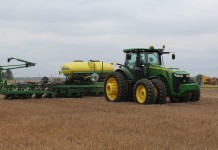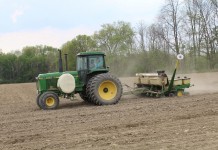WEST LAFAYETTE, Ind. — Hog producers may actually be helped by the current recession because of lower feed costs, said a Purdue University Extension marketing specialist.
Back into profitability
“Lower costs in combination with smaller pork supplies in 2009 could be the combination that puts the industry back into profitability,” said Chris Hurt. “Hog prices may actually increase a few dollars in 2009 as the pork industry in both the U.S. and Canada reduces breeding herds due to this year’s losses. However, many uncertainties continue for the pork industry.”
Hurt noted hog prices collapsed along with all other farm commodities. From a high of $62.56 average in August, live hog prices are expected to average about $39 for November.
The last time prices dropped this much from their summer highs was in 1998 when prices dropped by more than $25 per live hundredweight.
Demand factors
“Surprisingly, most of the decline is attributable to demand factors,” he said. “Pork exports were flying high this past spring and summer as a result of a weak U.S. dollar and aggressive buying by China prior to hosting the August Olympics.
In the period from April through July, exports represented 24 percent of U.S. production compared to 13 percent for the same period in 2007.
Since last summer, several events have reduced pork trade.
“After the Olympics, China greatly reduced their purchases from the U.S.,” he said.
In the first half of 2008, China accounted for 50 percent of the growth in U.S. pork exports. Their peak activity came in the second quarter when Chinese purchases reached about seven percent of all U.S. production.
Chinese purchases then collapsed in the third quarter, dropping by more than 60 percent to about 2.5 percent of U.S. production.
Exchange rate
Another factor is the exchange rate of the U.S. dollar, which has increased about 20 percent since July lows, making pork more expensive for foreign buyers.
This has resulted in USDA’s export projections being lowered by seven percent for 2008 and by a more robust 12 percent for all of 2009.
Severe impacts
The financial crisis has had severe impacts on hog prices as well, according to Hurt.
Since Sept. 26, when the crisis began to unfold, December lean hog futures have fallen by about $9 per carcass hundredweight, or about 14 percent.
The impact on meat consumption is related to concerns about the depth of the recession.
Generally, the negative impacts are greater for beef than for pork. Pork is generally a lower cost retail product relative to beef and is somewhat favored when consumers become more value conscious.
Retail pork prices so far this year have averaged $2.92 per pound compared to $4.31 for retail beef.
Meaning
What does all this mean for hog prices and producer incomes in the coming year?
According to Hurt, pork production is expected to drop by two to three percent in 2009. This may help hog prices average a few dollars per hundredweight higher than the $48 live price in 2008.
Somewhat higher hog prices will be welcomed by producers, but even more important may be lower feed prices.
Hurt noted estimated costs of production in 2008 were near $53, but current localized futures prices suggest costs could drop into the $46 to $48 range for 2009.
Forecasts
Current forecasts are for cash corn to average about $3.50 in the coming year compared to about $4.60 a bushel this year.
Soybean meal is currently about $260 (at Decatur, Ill.) for 2009, compared to an estimated $330 for this year.
Farrow-to-finish pork producers operated under losses for much of 2008, average about $5 per live hundredweight, or about $14 per hog.
For 2009, the current price relationship could return the industry to about $5 per hundredweight of profits as prices move from the mid-to-upper $40s in the first quarter to the lower-to-mid $50s in the second and third quarters and finish the year in the very high $40s.
Uncertainties
However, he repeated, uncertainties will abound, including the extent of the recession’s impact on domestic consumption and trade.
In addition, feed prices, while more moderate now, will remain a key to a profitable 2009, Hurt said.
Opportunities to both hedge lower feed prices and profitable lean hog futures prices for 2009 are now available.
All producers will welcome these improved prospects, and high-risk producers will especially want to consider taking some of these positive margins, according to Hurt.












